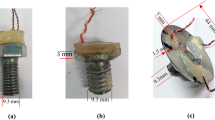Abstract
In this work experiments were carried out to study the correlation of the piezomagnetic field (B field) surrounding the steel tubular joints with the failure process of the joints under compressive as well as tensile loadings. The B fields were recorded by a highly sensitive fluxgate magnetometer of APS 428D. The piezomagnetic behavior of the steel tubular joints loaded up to failure is compared with the mechanical response. Results show that the piezomagnetic response seems to be a more sensitive indicator of the failure process than the mechanical one. This research has demonstrated that the piezomagnetic effect can be utilized as a nondestructive method to monitor the failure process of steel tubular joints under external loads.
Similar content being viewed by others
References
Villari, E., “Change of Magnetization by Tension and by Electric Current,” Annual Physics Chemistry 126: 87–122 (1865).
Bozorth, R.M., and Williams, H.J., “Effect of Small Stresses on Magnetic Properties,” Reviews of Modern Physics 17(1): 72–80 (1945).
Brown, W.F., “Irreversible Magnetic Effects of Stress,” Physical Review 75(1): 147–154 (1949).
Craik, D.J., and Wood, M.J., “Magnetization Changes Induced by Stress in a Constant Applied Field,” Journal of Physics D: Applied Physics 47: 1009–1016 (1970).
Birss, R.R., Faunce, C.A., and Isaac, E.D., “Magnetomechanical Effects in Iron and Iron-Carbon Alloys,” Journal of Physics D: Applied Physics 4(7): 1040–1048 (1971).
Kronmüller, H., “Magnetic Techniques for the Study of Dislocations in Ferromagnetic Materials,” International Journal of Nondestructive Testing 3: 315–350 (1972).
Jiles, D.C., and Atherton, D.L., “Theory of the Magnetisation Process in Ferromagnets and its Application to the Magnetomechanical Effect,” Journal of Physics D: Applied Physics 17(6): 1265–1281 (1984).
Erber, T., Guralnick, S.A., Desai, R.D., and Kwok, W., “Piezomagnetism and Fatigue,” Journal of Physics D: Applied Physics 30(20): 2818 (1997).
Guralnick, S.A., Bao, S., and Erber, T., “Piezomagnetism and Fatigue: II,” Journal of Physics D: Applied Physics 41(11): 115006 (2008).
Kaleta, J., and Zebracki, J., “Application of the Villari Effect in a Fatigue Examination of Nickel,” Fatigue and Fracture of Engineering Materials and Structures 19(12): 1435–1443 (1996).
Takahashi, S., Echigoya, J., and Motoki, Z., “Magnetization Curves of Plastically Deformed Fe Metals and Alloys,” Journal of Applied Physics 87(2): 805–813 (2000).
Squire, P.T., “Magnetomechanical Measurements and Their Application to Soft Magnetic Materials,” Journal of Magnetism and Magnetic Materials 160: 11–16 (1996).
Stevens, K.J., “Stress Dependence of Ferromagnetic Hysteresis Loops for Two Grades of Steel,” NDT and E International 32(2): 111–121 (2000).
Vértesy, G., Mészáros, I., and Tomáš, I., “Nondestructive Indication of Plastic Deformation of Cold-rolled Stainless Steel by Magnetic Minor Hysteresis Loops Measurement,” Journal of Magnetism and Magnetic Materials 285(3): 335–342 (2005).
Doubov, A.A., “Screening of Weld Quality Using the Magnetic Metal Memory Effect,” Welding in the World 41(3): 196–199 (1998).
Dong, L.H., Xu, B.S., Dong, S.Y., Chen, Q.Z., and Wang, D., “Variation of Stress-induced Magnetic Signals During Tensile Testing of Ferromagnetic Steels,” NDT and E International 41(3): 184–189 (2008).
Roskosz, M., and Bieniek, M., “Evaluation of Residual Stress in Ferromagnetic Steels Based on Residual Magnetic Field Measurements,” NDT and E International 45(1): 55–62 (2012).
Tanasienko, A.G., Suntsov, S.I., and Dubov, A.A., “Chemical Equipment Inspection with Using of Metal Magnetic Memory,” Khimicheskoe Neftegazov Mashinostroenie 10: 36–38 (2002).
Dubov, A.A., and Matyunin, V.M., “Early Diagnostics of Blade Damages with Using the Method of Magnetic Metal Memory,” Tyazheloe Mashinostroenie 10: 32–33 (2001).
Dubov, A.A., “A Technique for Monitoring the Heating Surface Tubes of Steam and Hot-water Boilers Using the Magnetic Memory of Metals,” Thermal Engineering 45(1): 59–63 (1998).
Dubov, A.A., and Kolokolnikov, S., “Quality Assurance of Welded Joints in Power, Chemical and Gas Pipeline Engineering by the Method of Metal Magnetic Memory,” Welding in the World 52: 709–714 (2008).
Bao, S., Erber, T., Guralnick, S.A., and Jin, W.L., “Fatigue, Magnetic and Mechanical Hysteresis,” Strain 47(4): 372–381 (2011).
Author information
Authors and Affiliations
Corresponding author
Rights and permissions
About this article
Cite this article
Bao, S., Lou, H., Gong, S. et al. Monitoring the Failure Process of Steel Tubular Joint by Piezomagnetic Measurements. Exp Tech 40, 849–856 (2016). https://doi.org/10.1007/s40799-016-0085-x
Published:
Issue Date:
DOI: https://doi.org/10.1007/s40799-016-0085-x




